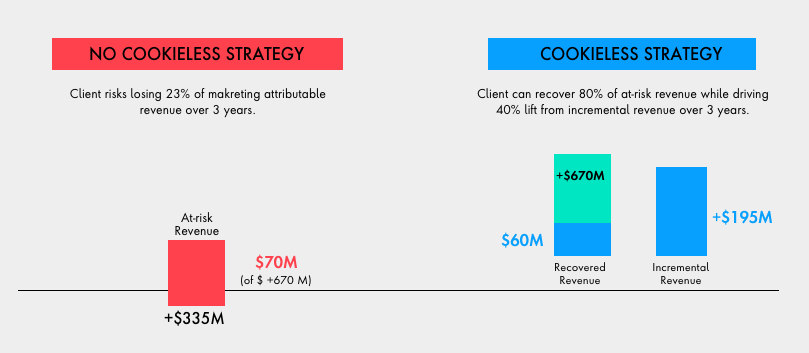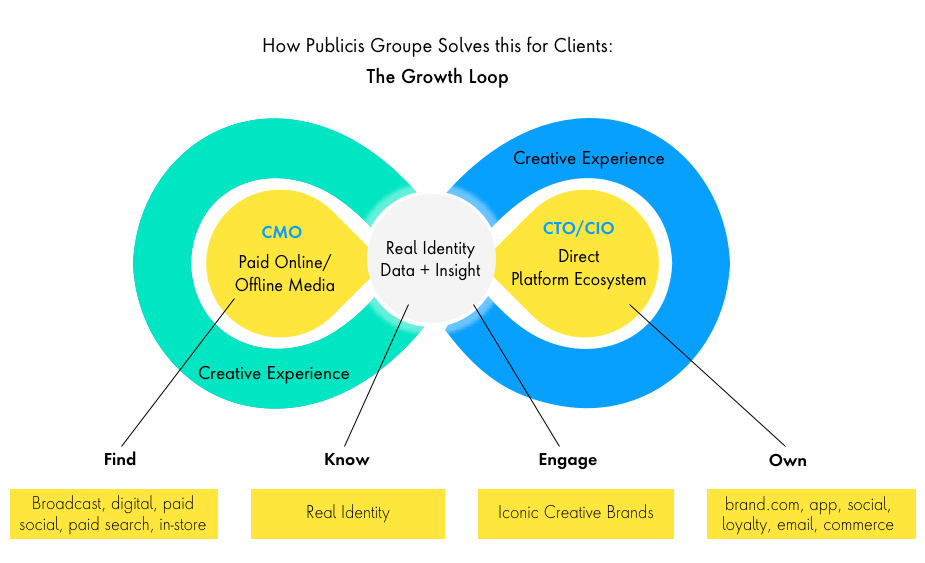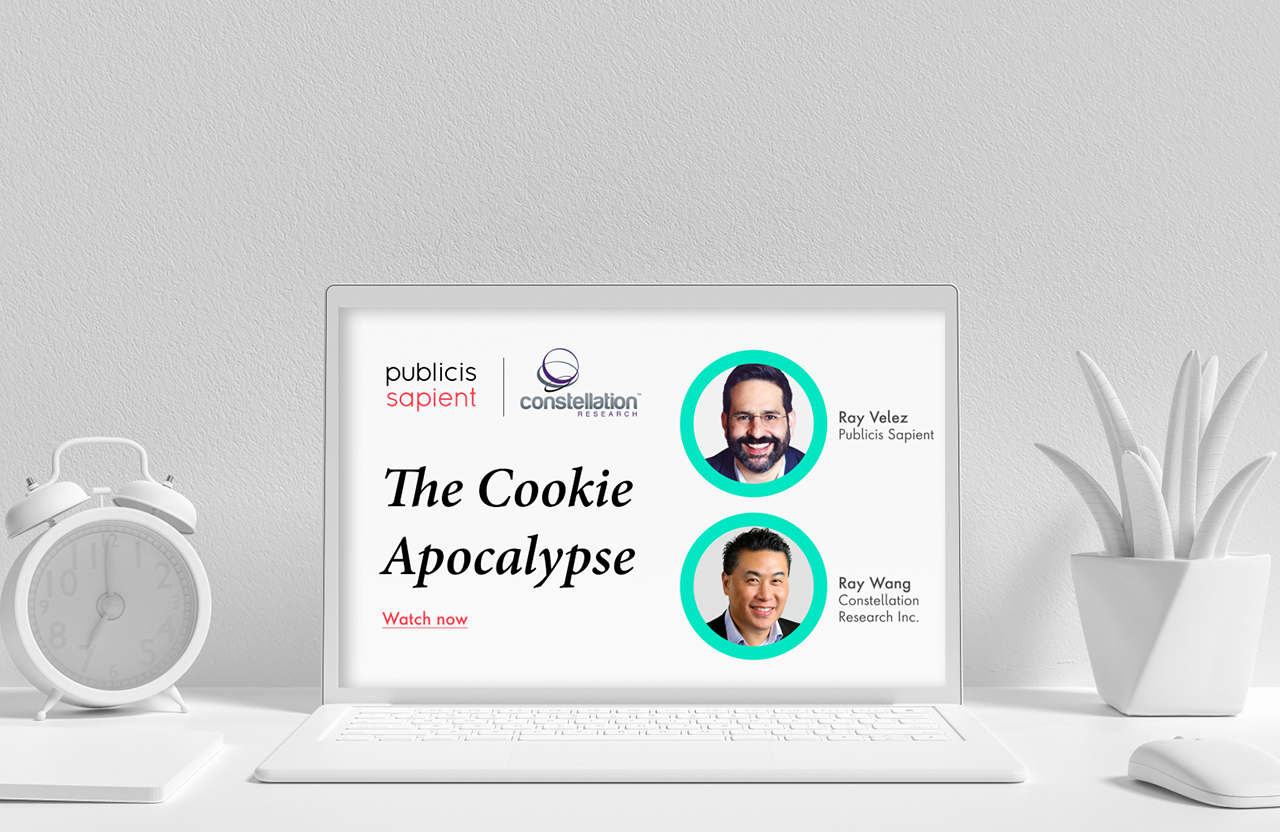What issue can we solve for you?
Type in your prompt above or try one of these suggestions
Suggested Prompt



Solutions
Cookie Apocalypse: Building Digital Resiliency in a Cookieless World
Cookie Apocalypse: Building Digital Resiliency in a Cookieless World
The deprecation of third-party cookies (3PCs) has been a steady but real looming threat to the status quo of how organizations do business and interact with customers.
Over the last decade, the institution of more stringent privacy laws, like the General Data Protection Regulation (GDPR) in the European Union and the California Consumer Privacy Act (CCPA) (among others) has forced organizations to overhaul their data practice standards to accommodate the appropriate governance and compliance to meet the demands of these new regulations.
In parallel, platform companies like Apple, Microsoft, Mozilla and Google have diminished or placed greater control over the use of third-party cookies on their search engines. Safari (Apple), Firefox (Mozilla) and Edge (Microsoft) already banned 3PCs and provide capabilities that periodically delete first-party cookies.
Earlier this year, Apple and Google doubled down on efforts to limit how cookies are used. In April, Apple announced they would be limiting the use of its Identifier for Advertisers (IDFA) in their iOS systems, giving users the option to opt-in. This requires first going into settings after the IOS 14 update and asking users to opt-in to tracking. Google’s move to eliminate 3PCs from Chrome is another massive shift, effectively wiping the use of 3PCs from a browser that effectively owns 48 percent market share.
The effects can be felt already. According to initial reports, upon launch, only 4 percent of U.S. consumers chose to allow apps to access their IDFA tags. Facebook, which relies on 3PCs to effectively advertise on their network, warned investors of potential revenue impact, and began testing new ways to acquire consent from their users in response.
The lasting effects of these changes threaten more than just digital advertising. It snaps the thread of what enables organizations to achieve a true 360-view of the customer. If organizations do not put a plan in place that future-proofs their data infrastructure, authentication capabilities and data collection practices to consistently deliver strong business outcomes, they risk losing ground on progress they’ve already made improving targeting, personalization and experiential relationships with consumers. At Publicis Sapient, we have found that organizations that are not prepared for this shift risk losing up to 23 percent of their marketing attributable revenue over the next three years.

In short, the pursuit of a deep understanding of the customer, and potential revenue opportunities, hang in the balance. And the clock is ticking.
The Power of First-Party Data
At the center of this challenge is strength of an organization’s first-party data strategy. First-party data is collected from an organization’s owned channels, like a website, app, or in-store point-of-sale system and used to help track all the interactions a customer may have with a brand. A robust first-party data system decreases reliance on alternate data sources and increases the quality and accuracy of the information, since it was collected from a direct relationship an organization has with a consumer.
“Brands that are able to build out and better utilize their first party data assets are realizing there’s more potential than they understood,” Dana Moroze, SVP, Epsilon Platform Solutions, said.
Consumers interact with brands across many touchpoints, with different data collected across each part of the journey. In siloed organizations, this data is not always consolidated to give a true view of a consumer’s relationship with a brand. Siloed customer data may also be inconsistent, resulting in inaccuracies or redundancies that may lead to wasted spend.

Further, organizations are often not able to collect all the contextual data they need to create a complete customer profile through owned channels alone. Typically, organizations leverage second-party data (data shared through trusted partnerships, like a retailer and supplier, for example) or third-party data to fill in those gaps.
But with third-party data diminishing, organizations need to shift from device or cookie-based marketing to people-based marketing, with strategies that focus on diversifying first and second-party data to achieve an understanding of the customer that goes beyond solely cookie or device identifiers. Second, organizations need to create an environment that allows data to be cleaned, analyzed, and shared in a way that ensures privacy regulations are validated.
For example, say a consumer provides multiple email addresses when engaging with a company across different channels. While the email address belongs to the same customer, if this data exists across silos, it may lead to duplicate marketing efforts or inconsistent experiences. Further, some data privacy regulations mandate the “right to be forgotten,” where consumers can request for removal of personal data from a system. Organizations would have to ensure all data tying back to a customer is removed from all systems, which can be challenging if said customer data exists in multiple sources across the business.
Achieving this requires organizations to rethink the way they interact with consumers, building direct relationships based on trust and value exchange that will ultimately strengthen the efficacy of first-party data. On the backend, organizations also must innovate how they work with data partners to strengthen the quality of data from alternate sources.
“Brands could ultimately emerge from this transition with a stronger view of their customers than they’ve ever had before,” Moroze said.
1. View Data as a Value Exchange
Evolving privacy regulations are intended to place the power of choice and visibility into how personal data is handled into the hands of the consumer. Opting out of data sharing, though, can often limit the quality of products or services that rely on personalization to drive better experiences. This creates a relationship of value between a brand and a consumer – a mutual understanding that opting in or sharing information will result in relevant, contextualized experiences the consumer is looking for.
According to Publicis Sapient data, 61 percent of consumers do not know what companies do with their information, and 40 percent do not believe the data they share always equates to the value they receive in return.
In response, organizations have an opportunity to create a more transparent relationship with consumers, educating them on privacy standards and how their data is used to provide services. Brands also have an opportunity to develop new products, services and campaigns that directly engage consumers on owned channels, creating a direct conversation between shopper and brand.
“Every campaign is an opportunity to gain first-party data,” Brianna Taylor, senior data analyst, Digitas, said. “There's a lot of brands where creating apps or log-in states don't make sense, so campaigns are going to play a bigger role in how we start and maintain conversations with consumers.”
2. Strengthen quality of data systems
Implementing a future-proof data system is not a one-size-fits-all journey. Organizations need to understand the current state of their infrastructure and what innovations are needed to create the best data environment.
Customer Data Platforms (CDP): An enterprise-ready CDP leveraging modern cloud infrastructures should be at the center of any data strategy. An organization’s CDP should be equipped to move beyond data storage, with the ability to analyze and activate on insights from across the organization in real time. Organizations must also be able to cut through the noise and accurately produce a singular customer identity across all channels, giving a consistent, accurate view while upholding regulatory practices.
The core capabilities of an enterprise-ready CDP:
REAL-TIME CUSTOMER PROFILE
The best experiences start with real-time customer intelligence. Brands have mountains of customer data, and it’s likely stored across different systems, making it hard to really understand their customers.
MACHINE LEARNING DECISIONING
The customer journey is constantly changing with every new interaction an individual has (with your brand or with others). The next best interaction should always be driven by machine learning, with the most up-to-date information on the consumer journey.
IDENTITY
Across a consumer’s journey, one or many personal identifiers may be associated with an individual. This should comprise the brand’s ID graph and their identity resolution partner to fill in the gaps of a brand’s own data.
MEASUREMENT
Brands need to ensure their measurement and attribution efforts are accurate at the individual, household and business level across channels, both offline and online.
SCALABLE AUDIENCES
Brands need to ensure their first-party data can be leveraged across platforms, not just work on one system but fall flat on another.
PRIVACY AND DATA GOVERNANCE
Real transparency and control for the consumer is a must. Governance and consent tools manage how information is collected, when they can be used and for what purpose.
Walled Garden and Open Private Cleanrooms: Data shared between trusted partners is an asset for providing deeper contextual customer information beyond first-party sources. Open Private Clean Rooms enable brands full control on matching data with partners and publishers through regulatory compliant co-ops, allowing brands to come together to provide fully orchestrated experiences across products and services.
Data Monetization: Many organizations already have a wealth of data or established partnerships in place, but aren’t leveraging data to maximize revenue opportunities across the customer journey. Organizations must work with data partners to collect and share data between parties effectively. Not only will these data monetization-based experiences improve experiences for customers, but also provide the signal brands need to create relevant experiences.
Identity Resolution: An identity resolution solution needs to be the underpinning of a future-proof enterprise CDP. This solution works to capture customer engagement and data from a variety of sources and tie it back to a singular customer identity, removing risk of redundancy or inaccuracies. Identity resolution can also help shore up inconsistencies in third-party data, tying back anonymous data to known customers if they exist in the system. Making sure you treat consumers consistently across their devices and within households requires an identity partner.
Conclusion
Digital marketing, advertising, and how data is applied across organizations has been maturing over the last decade. A world without cookies is the next step, with plenty of silver linings. A focus on first-party relationships gives brands opportunity to really listen to their customers and build new experiences they truly benefit and value – benefitting both brands and consumers. Further data independence will also help organizations truly use their data to its greatest extent, leading to stronger partnerships, new revenue opportunities and better business outcomes.
Related Reading
-
![]()
Insight
Your Cookieless Future
As privacy practices continue to evolve, how can your business understand and respond to customer needs?
-
![]()
Webinar
Cookie Apocalypse
Watch Ray Wang from Constellation Inc. webinar info here.
-
![]()
Quiz
Cookieless Opportunity Quiz
Assess your cookieless opportunities in just four questions.







